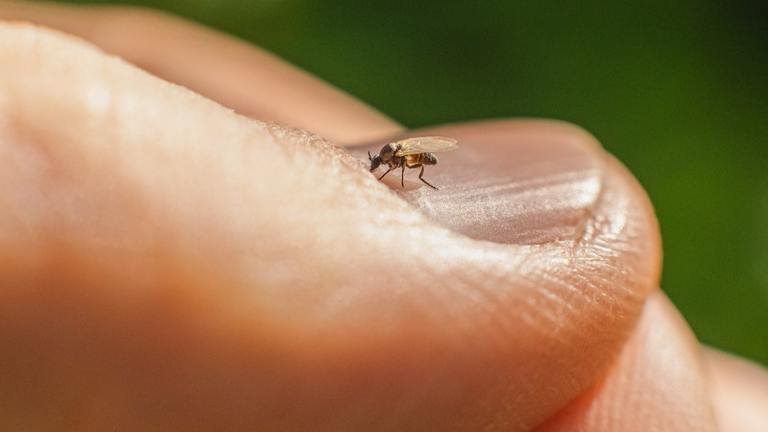No See Ums: The Tiny Pests That Pack a Big Bite
Published: March 21, 2025

What Are No See Ums?
If you’ve ever spent time outdoors and suddenly felt tiny, painful bites without seeing the culprit, you may have encountered no see ums. These nearly invisible pests can turn a pleasant evening into an itchy nightmare. In this guide, we’ll explore what they are, why they are a problem, and how you can protect your home and yard from these annoying insects.
Also known as biting midges or sand flies, belong to the Ceratopogonidae family. They are tiny—typically measuring less than 3 millimeters in length—making them difficult to see with the naked eye. Despite their size, no see ums deliver painful bites that can cause intense itching, redness, and even allergic reactions in some individuals.
These pests thrive in warm, humid environments and are commonly found in coastal areas, wetlands, and even residential backyards with standing water. They are most active during dawn and dusk when temperatures are mild.
Why Are They a Problem?
While mosquito bites are annoying, no see ums bites can be even worse due to their size and feeding habits. Unlike mosquitoes, which have long proboscises to pierce the skin, no see ums use cutting mandibles to slice open the skin and lap up the blood. This results in bites that are often more painful and leave behind itchy, inflamed welts.
Health Risks Associated
Beyond irritation and discomfort, no see ums can pose certain health risks:
- Allergic Reactions: Some people experience severe allergic reactions to no see ums bites, including swelling and blistering.
- Disease Transmission: While rare in the United States, They are known to transmit diseases such as the Oropouche virus in other parts of the world.
- Secondary Infections: Scratching bites can lead to skin infections, particularly in children and those with sensitive skin.

1. Habitat and Breeding Patterns
Research conducted by the University of Florida shows that they breed in damp environments, particularly in moist soil, marshes, and areas with decaying vegetation. Their larvae develop in water, much like mosquitoes, which makes controlling their populations challenging.
2. Attractants and Repellents
A study published in the Journal of Insect Science found that no see ums are attracted to carbon dioxide, lactic acid, and certain body odors. This explains why some people seem to get bitten more than others.
On the flip side, research suggests that essential oils like eucalyptus, citronella, and neem oil can help repel these pests, making them a natural alternative to chemical repellents.
3. Effective Control Methods
A report from the National Pest Management Association (NPMA) indicates that the most effective way to control them is through a combination of professional pest control treatments and habitat modification. Eliminating standing water, using fine mesh screens, and applying insecticides in breeding areas can drastically reduce their numbers.
How to Prevent and Get Rid of No See Ums
1. Eliminate Breeding Grounds
- Remove standing water around your property.
- Keep gutters clean to prevent water buildup.
- Trim vegetation and remove decaying plant matter.
2. Use Protective Barriers
- Install fine-mesh screens on windows and doors.
- Wear long sleeves and pants when spending time outdoors.
- Use bed nets if you live in an area with a heavy infestation.
3. Apply Repellents
- Use insect repellents containing DEET or picaridin.
- Try essential oil-based repellents as a natural alternative.
- Consider fogging treatments for high-risk areas.

Traditional Pest Control Methods for No See Ums
While DIY solutions can help reduce their population, traditional pest control methods remain the most effective for long-term relief. Here are some tried-and-true pest control strategies:
1. Chemical Treatments
Professional exterminators use targeted insecticides to eliminate no see ums from their breeding and resting sites. These treatments are particularly effective when applied around marshy areas, patios, and doorways.
2. Barrier Sprays
Barrier sprays involve treating the exterior perimeter of a home or yard with long-lasting insecticides. This creates a protective barrier that prevents no see ums from entering indoor spaces.
3. Fogging and Misting Systems
For large outdoor areas, fogging or misting systems are an effective way to control no see ums. These treatments distribute insecticides evenly across an area, providing immediate relief.
4. Larvicides
Since they breed in water, larvicides are used to target their immature stages. This disrupts their life cycle and prevents them from maturing into biting adults.
5. Professional Monitoring and Maintenance
Regular pest control services ensure that no see ums populations remain under control. Experts conduct inspections, identify problem areas, and implement customized solutions to keep your property pest-free.
6. Integrated Pest Management (IPM)
Many pest control professionals use an Integrated Pest Management approach, which combines multiple strategies such as habitat modification, chemical treatments, and biological controls to achieve long-term effectiveness with minimal environmental impact.
Professional Pest Control Solutions
If no see ums continue to be a problem, professional pest control services like All U Need Pest Control can provide targeted treatments to eliminate these pests from your home and yard. Expert technicians use specialized insecticides and habitat modification techniques to significantly reduce no see ums populations.
Final Thoughts
No see ums may be tiny, but their bites can be incredibly frustrating. By understanding their habits, eliminating breeding grounds, and using proven repellents, you can protect yourself from these pesky insects. Traditional pest control methods, such as barrier sprays, fogging, and chemical treatments, offer effective, long-term relief.
For expert pest control solutions, contact All U Need Pest Control today and reclaim your outdoor space!